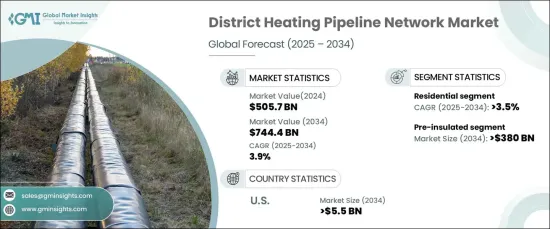PUBLISHER: Global Market Insights Inc. | PRODUCT CODE: 1666908

PUBLISHER: Global Market Insights Inc. | PRODUCT CODE: 1666908
District Heating Pipeline Network Market Opportunity, Growth Drivers, Industry Trend Analysis, and Forecast 2025 - 2034
The Global District Heating Pipeline Network Market, valued at USD 505.7 billion in 2024, is set to grow at a steady CAGR of 3.9% between 2025 and 2034. This growth reflects a transformative shift toward sustainable energy technologies and a heightened demand for energy-efficient heating systems. District heating pipelines offer a solution to modern energy challenges by reducing heat loss, improving energy conservation, and aligning with global sustainability goals.

As urban populations expand and governments enforce stricter energy standards, the adoption of district heating solutions is poised to accelerate. These systems not only enhance energy efficiency but also significantly lower carbon emissions, making them a cornerstone of smart city initiatives. Their ability to integrate renewable energy sources such as biomass, solar thermal, and geothermal energy underscores their importance in creating resilient, eco-friendly infrastructure. Furthermore, the economic benefits-reduced energy costs and long-term operational efficiency-make district heating pipelines an attractive investment for residential, commercial, and industrial applications worldwide.
| Market Scope | |
|---|---|
| Start Year | 2024 |
| Forecast Year | 2025-2034 |
| Start Value | $505.7 Billion |
| Forecast Value | $744.4 Billion |
| CAGR | 3.9% |
The pre-insulated district heating pipeline network is anticipated to generate USD 380 billion by 2034, driven by increasing investments in sustainable infrastructure. These pipelines are engineered to endure high temperatures and deliver unmatched durability, making them ideal for regions with extensive heating requirements. Their innovative design minimizes heat loss, optimizes energy consumption, and supports large-scale urban projects. As developers prioritize energy-efficient technologies, pre-insulated pipelines have become synonymous with modern, sustainable heating systems. Their role in reducing thermal inefficiencies and lowering greenhouse gas emissions positions them as a pivotal solution for cities aiming to achieve environmental benchmarks.
In the residential sector, the district heating pipeline market is projected to grow at a rate of 3.5% through 2034. The rising preference for eco-friendly heating solutions in densely populated urban areas is a key factor propelling this growth. District heating systems provide a seamless and cost-effective method for heating homes and supplying hot water while reducing reliance on individual heating units. Their compatibility with renewable energy sources further enhances their appeal, enabling households to transition toward greener energy options. With governments emphasizing carbon neutrality and energy efficiency, residential adoption of district heating systems is expected to surge, making them an integral part of future urban planning.
In the United States, the district heating pipeline network market is forecasted to generate USD 5.5 billion by 2034. Significant investments in urban development and energy-efficient infrastructure are driving this growth. Cities across the country are implementing advanced district heating systems to meet energy mandates and decarbonization goals. Pre-insulated pipelines, with their ability to reduce thermal losses and improve operational efficiency, are becoming indispensable for urban heating projects. As municipalities strive to lower greenhouse gas emissions and incorporate renewable energy into their frameworks, the demand for cutting-edge heating solutions continues to rise, positioning the US as a pivotal market for district heating networks.
Table of Contents
Chapter 1 Methodology & Scope
- 1.1 Market scope & definitions
- 1.2 Market estimates & forecast parameters
- 1.3 Forecast calculation
- 1.4 Data sources
- 1.4.1 Primary
- 1.4.2 Secondary
- 1.4.2.1 Paid
- 1.4.2.2 Public
Chapter 2 Executive Summary
- 2.1 Industry synopsis, 2021 - 2034
Chapter 3 Industry Insights
- 3.1 Industry ecosystem analysis
- 3.2 Regulatory landscape
- 3.3 Industry impact forces
- 3.3.1 Growth drivers
- 3.3.2 Industry pitfalls & challenges
- 3.4 Growth potential analysis
- 3.5 Porter's analysis
- 3.5.1 Bargaining power of suppliers
- 3.5.2 Bargaining power of buyers
- 3.5.3 Threat of new entrants
- 3.5.4 Threat of substitutes
- 3.6 PESTEL analysis
Chapter 4 Competitive Landscape, 2024
- 4.1 Introduction
- 4.2 Strategic outlook
- 4.3 Innovation & sustainability landscape
Chapter 5 Market Size and Forecast, By Pipe, 2021 – 2034 (km & USD Billion)
- 5.1 Key trends
- 5.2 Pre-insulated steel
- 5.3 Polymer
Chapter 6 Market Size and Forecast, By Diameter, 2021 – 2034 (km & USD Billion)
- 6.1 Key trends
- 6.2 20-100 mm
- 6.3 101-300 mm
- 6.4 ≥300 mm
Chapter 7 Market Size and Forecast, By Application, 2021 – 2034 (km & USD Billion)
- 7.1 Key trends
- 7.2 Residential
- 7.3 Commercial
- 7.4 Industrial
Chapter 8 Market Size and Forecast, By Region, 2021 – 2034 (km & USD Billion)
- 8.1 Key trends
- 8.2 North America
- 8.2.1 U.S.
- 8.2.2 Canada
- 8.3 Europe
- 8.3.1 Germany
- 8.3.2 Poland
- 8.3.3 Sweden
- 8.3.4 Russia
- 8.3.5 Italy
- 8.3.6 UK
- 8.3.7 Finland
- 8.3.8 Denmark
- 8.4 Asia Pacific
- 8.4.1 China
- 8.4.2 Japan
- 8.4.3 South Korea
Chapter 9 Company Profiles
- 9.1 Aquatherm
- 9.2 Brugg Pipes
- 9.3 CPV
- 9.4 Golan Plastic Products
- 9.5 Isoplus
- 9.6 Ke Kelit
- 9.7 Logstor
- 9.8 Mannesmann Line Pipe
- 9.9 Microflex
- 9.10 Perma-Pipe
- 9.11 Pipelife
- 9.12 Rehau
- 9.13 Thermaflex
- 9.14 Uponor




